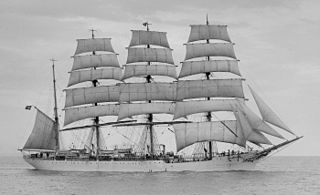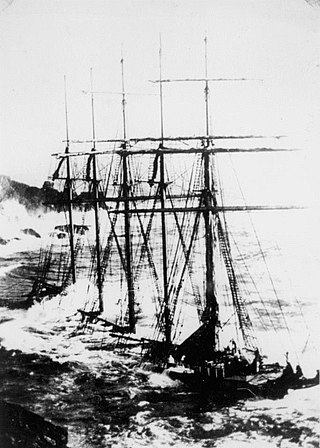
A sailing vessel's rig is its arrangement of masts, sails and rigging. Examples include a schooner rig, cutter rig, junk rig, etc. A rig may be broadly categorized as "fore-and-aft", "square", or a combination of both. Within the fore-and-aft category there is a variety of triangular and quadrilateral sail shapes. Spars or battens may be used to help shape a given kind of sail. Each rig may be described with a sail plan—formally, a drawing of a vessel, viewed from the side.

A barque, barc, or bark is a type of sailing vessel with three or more masts and mainmasts rigged square and only the mizzen rigged fore and aft. Sometimes, the mizzen is only partly fore-and-aft rigged, bearing a square-rigged sail above.

USCGC Eagle (WIX-327), formerly the Horst Wessel and also known as the Barque Eagle, is a 295-foot (90 m) barque used as a training cutter for future officers of the United States Coast Guard. She is one of only two active commissioned sailing vessels in the United States military today, along with USS Constitution which is ported in Boston Harbor. She is the seventh Coast Guard cutter to bear the name in a line dating back to 1792, including the Revenue Cutter Eagle.

A barquentine or schooner barque is a sailing vessel with three or more masts; with a square rigged foremast and fore-and-aft rigged main, mizzen and any other masts.

The Flying P-Liners were the sailing ships of the German shipping company F. Laeisz of Hamburg.

Belem is a three-masted barque from France.

Pommern, formerly Mneme (1903–1908), is an iron-hulled sailing ship. It is a four-masted barque that was built in 1903 at the J. Reid & Co shipyard in Glasgow, Scotland.

A jackass-barque, sometimes spelled jackass bark, is a sailing ship with three masts, of which the foremast is square-rigged and the main is partially square-rigged and partially fore-and-aft rigged (course). The mizzen mast is fore-and-aft rigged.

STS Sedov, formerly Magdalene Vinnen II (1921–1936) and Kommodore Johnsen (–1948), is a four-masted steel barque that for almost 80 years was the largest traditional sailing ship in operation. Originally built as a German cargo ship, Sedov is today a sail training vessel, training cadets from the universities of Kaliningrad, Saint Petersburg and Astrakhan. She participates regularly in the big maritime international events as a privileged host and has also been a regular participant in The Tall Ships' Races.

Viking is a four-masted steel barque, built in 1906 by Burmeister & Wain in Copenhagen, Denmark. She is reported to be the biggest sailing ship ever built in Scandinavia. In the 21st century her sailing days have drawn to a close, and is now moored as botel in Gothenburg, Sweden.
Friedrich Krupp Germaniawerft was a German shipbuilding company, located in the harbour at Kiel, and one of the largest and most important builders of U-boats for the Kaiserliche Marine in World War I and the Kriegsmarine in World War II. The original company was founded in 1867 but went bankrupt and was bought out by Friedrich Krupp. Krupp was very interested in building warships and in the time before the First World War built a number of battleships for the Kaiserliche Marine, including SMS Posen, SMS Prinzregent Luitpold, SMS Kronprinz, and SMS Sachsen. A total of 84 U-boats were built in the shipyard during the war. After the war it returned to the normal production of yachts and transports.

HMS Somali was a Tribal-class destroyer of the British Royal Navy that saw service in World War II. She was launched in 1937, captured the first prize of World War II and served in Home and Mediterranean waters. She was torpedoed on 20 September 1942 in the Arctic and foundered five days later while under tow.

Potosi was a five-masted steel barque built in 1895 by Joh. C. Tecklenborg ship yard in Geestemünde, Germany, for the sailing ship company F. Laeisz as a trading vessel. Its primary purpose was as a "nitrate clipper" collecting guano in South America for use in chemical companies in Germany. As its shipping route was between Germany and Chile, it was designed to be capable of withstanding the rough weather encountered around Cape Horn.

Gustaf Adolf Mauritz Erikson was a ship-owner from Mariehamn, in the Åland islands. He was famous for the fleet of windjammers he operated to the end of his life, mainly on the grain trade from Australia to Europe.

The Tall Ships Races are races for sail training "tall ships". The races are designed to encourage international friendship and training for young people in the art of sailing. The races are held annually in European waters and consists of two racing legs of several hundred nautical miles, and a "cruise in company" between the legs. Over one half of the crew of each ship participating in the races must consist of young people.

Adolf Vinnen was a five-masted barquentine that was built by Friedrich Krupp Germaniawerft, Kiel, Germany. She was wrecked on her maiden voyage in 1923.
Adolf Vinnen was a weather ship that was built in 1929 as the fishing vessel Gustav Adolf Kühling. She was renamed in 1930. The ship was requisitioned by the Kriegsmarine in March 1940, serving until 23 October 1940 when she was sunk by HMS Matabele, HMS Punjabi and HMS Somali.
Hinrich Freese was a fishing trawler built in 1930 by Deutsche Schiff- und Maschinenbau AG for the Hanseatische Hochseefisherei AG. She was requisitioned by the Kriegsmarine in 1940, serving until deliberately wrecked in November 1940 whilst being chased by the British cruiser HMS Naiad.














